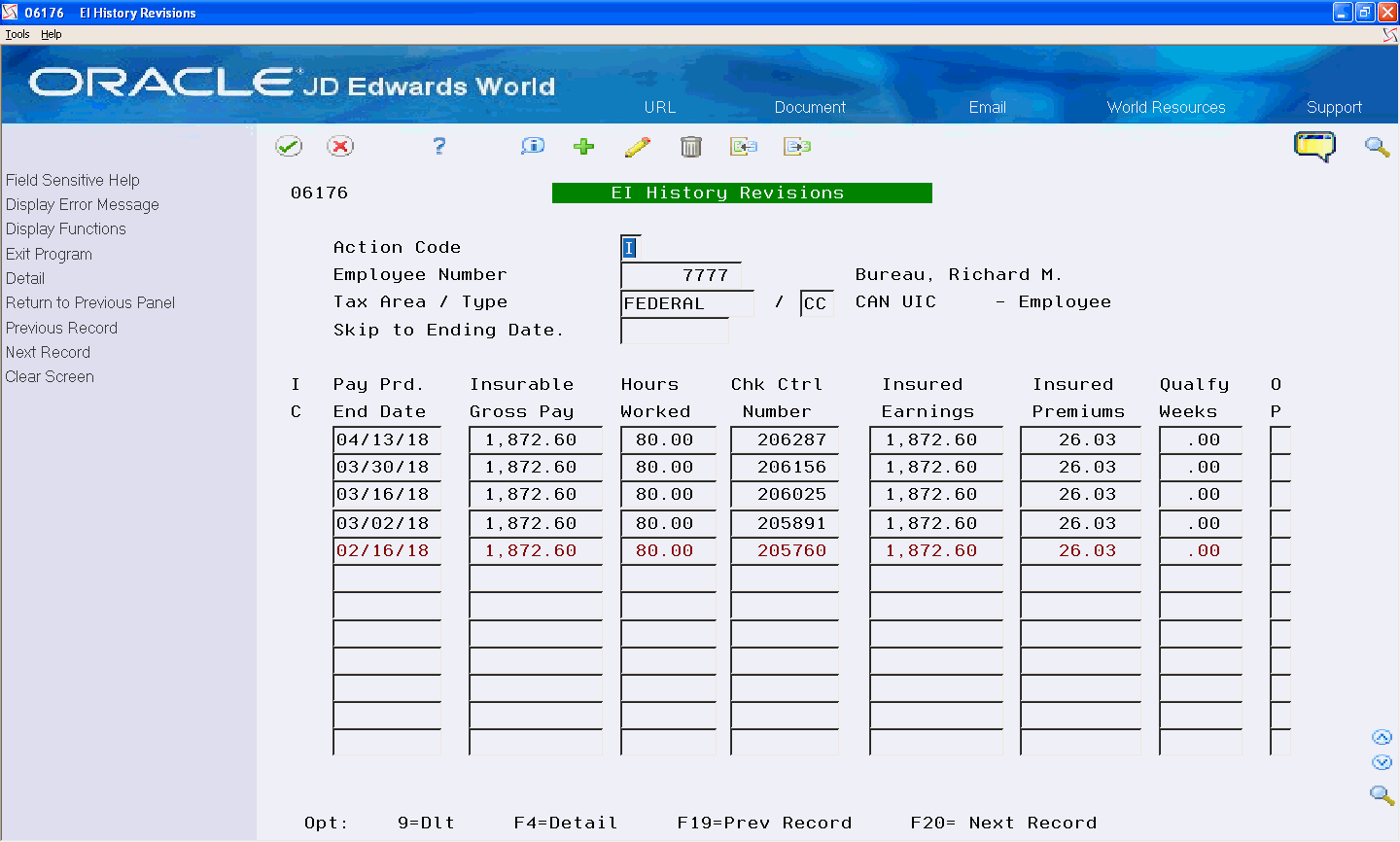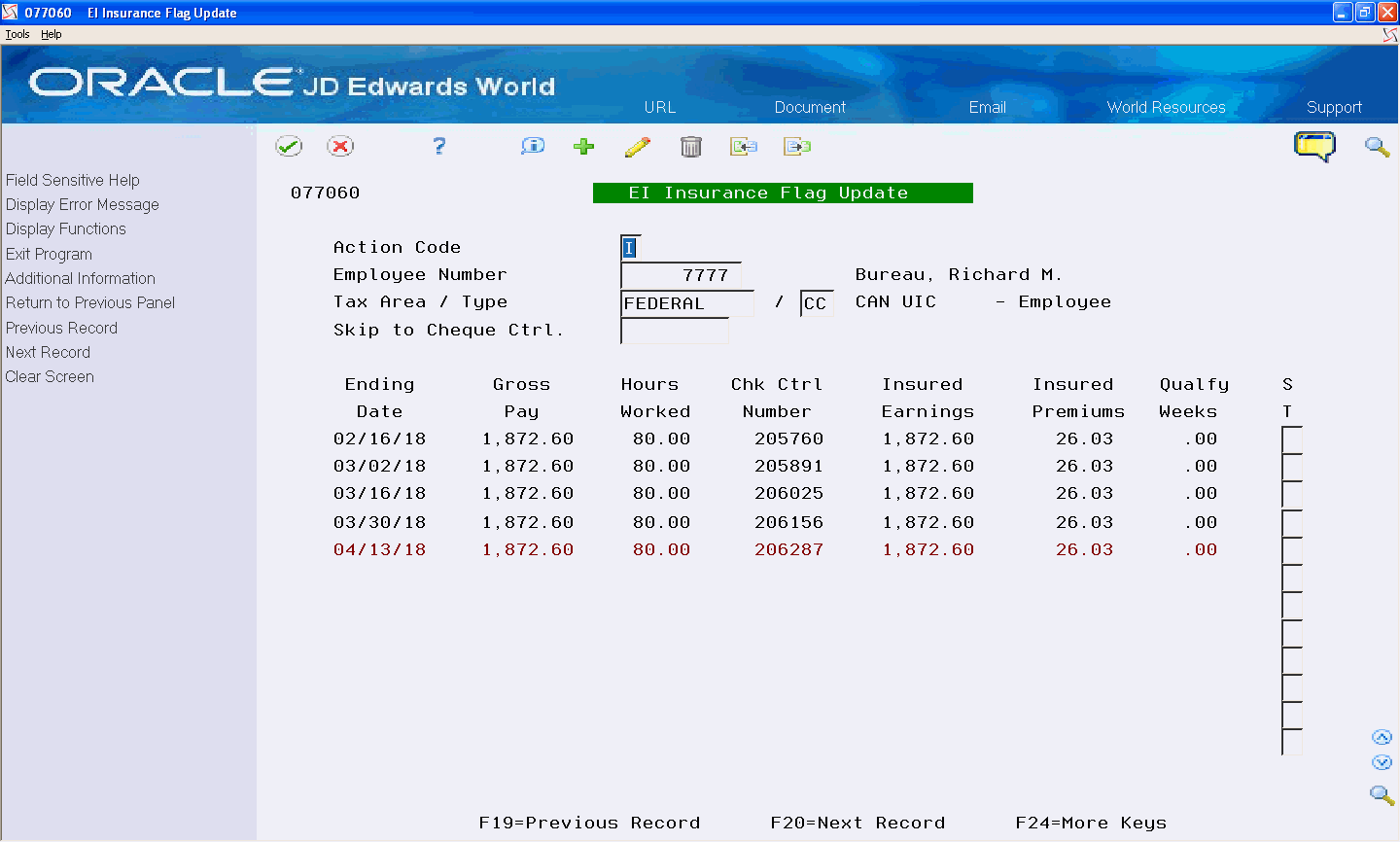4 Working with Employment Insurance History Integrity
Before you begin processing year-end forms, you must verify the integrity of your historical information.
You verify the integrity of employment insurance (EI) information to ensure that you report the correct information to the government. If you discover errors, you review each error to verify whether you must make a change to the employment insurance history. If a change is necessary, you revise the employment insurance history to correct the error.
You can use the Payroll History Audit report to verify that detail information corresponds to summary history information. You must run this report periodically throughout the year. See Verifying Employment Insurance Hour Integrity
This chapter contains the following topics:
-
Section 4.1, "Verifying Employment Insurance History Integrity"
-
Section 4.3, "Working with Employment Insurance Hour Integrity"
4.1 Verifying Employment Insurance History Integrity
From EI Integrity (G77311), choose EI Integrity Validation
You run the EI Integrity Validation program to find discrepancies between the Unemployment Insurance History (F06176) and Tax History Summary (F0713) tables. This program ensures that the gross earning and EI contribution amounts are the same in the two tables.
This program summarizes all records for each employee in the Unemployment Insurance History table by tax type CC and compares the results with the amounts in the Tax History Summary table.
If the yearly totals for EI insurable earnings in the Unemployment Insurance History table do not match the gross earnings minus excludables minus in-excess in the Tax History Summary table, the program marks the records. The program then compares the records in the Unemployment Insurance History table with the records in the Tax Ledger table (F0716) by cheque control number to locate specific records that do not match. The program then produces an exception report, the EI Integrity F0716/F06176 Exceptions report.
The EI Integrity Validation program produces a second exception report, the EI Integrity Validation report, if any of the following conditions exist:
-
The amount of insurable earnings is greater than the maximum EI earnings.
-
The tax ID in the Unemployment Insurance History table does not match any of the corporate tax IDs that are set up for the company in the Tax Area Constants table (F069016).
-
The employee number does not exist in the Employee Master table (F060116).
-
The company number does not exist in the Corporate Tax ID table (F069086).
-
The maximum EI earnings do not exist for the company.
-
The employee record does not exist in the Tax Ledger table (F0716).
-
The amount of insurable earnings or tax does not match the amount in the Tax Ledger table.
The EI Integrity Validation program reads information from the Unemployment Insurance History, Tax History Summary, and Tax Ledger tables. It does not update these tables.
4.2 Revising Employment Insurance History
When you verify the integrity of your employment insurance history, you might discover errors. You review each error to verify whether you must make a change as some errors might reflect valid conditions. Use the EI History Revisions program (P06176) to locate any employee's employment insurance history and, if necessary, to make revisions.
Records on a Record of Employment (ROE) do not appear on the EI History Revisions screen because the system locks these records and you cannot revise them. To review locked records on an ROE, use the EI History Inquiry program (P060991).
This program revises information in the Unemployment Insurance History table (F06176).
To revise employment insurance history
From EI Integrity (G77311), choose EI History Revisions
-
On EI History Revisions, to locate the employee's EI history, complete the Employee Number field and click Enter.
-
Revise the information in any of the following fields and click Change:
-
Pay Period End Date
-
Insurable Gross Pay
-
Hours Worked
-
Insured Earnings
-
Insured Premiums
-
| Field | Explanation |
|---|---|
| Insurable Gross Pay | The actual gross pay amount for an employee. This amount is different from the distributed gross pay amount that is used for labour distribution.
Screen-specific information The employee's insurable gross pay for the listed pay period. This amount is subject to EI (employment insurance) before EI limits are applied. |
| Hours Worked | The number of hours associated with each transaction.
Screen-specific information The hours excluded from employment insurance (EI) with Tax Type CI are not included in this field. The associated pay is included in the Insurable Gross Pay. The excluded hours are included in the actual hours worked on the employee's timecard. |
| Insured Earnings | The amount that is subject to taxation or withholdings.
Screen-specific information For Canadian employment insurance (EI), this amount equals the gross pay to which EI applies. When the sum of the insured earnings exceeds the yearly maximum, the next entry for that year is blank. When you enter revisions manually, the system determines whether the amount that you enter plus the sum of the insured earnings for the year exceeds the yearly limit. |
| Insured Premiums | The employment insurance premium withheld from the employee's pay for the current pay period.
Screen-specific information If the premium percentage is specified in the processing options, the system calculates the premium amount to withhold. To enter an amount manually, leave the processing option blank. |
4.2.1 Processing Options
See Employment Insurance History Rev. (P06176)
See Also:
-
Revising Employment Insurance History for more information about using the EI History Inquiry screen to review employment insurance history
4.3 Working with Employment Insurance Hour Integrity
You run the EI Hour Integrity program to find and correct discrepancies between the Unemployment Insurance History (F06176) and the Payroll Transaction History (F0618) tables. This allows you to ensure that no discrepancy exists in insurable hours worked for employment insurance.
When you run the EI Hour Integrity program in verification mode, the system identifies records with discrepancies so that it can resolve those discrepancies when you run the program in update mode. Before you run the program in update mode, you can manually reset the flag for certain records to prevent the program from updating them. This might be necessary if you have records that the system considers to be in error but, in fact, are not.
Working with employment insurance hour integrity includes the following tasks:
-
Verifying employment insurance hour integrity
-
Updating employment insurance flags
4.3.1 Verifying Employment Insurance Hour Integrity
From EI Integrity (G77311), choose EI F06176 Hour Validation
You run the EI Hour Integrity program (P077020) to locate and correct discrepancies between the Unemployment Insurance History (F06176) and the Payroll Transaction History (F0618) tables. This program ensures that no discrepancies exist in insurable hours worked for employment insurance.
You must run this program in verification mode before you can run it in update mode. Running the program in verification mode sets a flag that the program uses when you run it in update mode.
When you run the EI Hour Integrity program in verification mode, the system compares the number of hours for each employee in the Employment Insurance History and Payroll Transaction History tables. If the totals do not match, the system does one of the following:
-
If no corresponding records exist in the Payroll Transaction History table, the system prints an error message on the report (No time card control record).
-
If the totals differ, the program uses the pay type, employee number, and cheque control number to locate the corresponding record in the Payroll Month PDBA Summary History table. Data should exist for the record in either the Effect on Gross Pay or Effect on Net Pay field in the Payroll Month PDBA Summary History table. If both fields are blank, the program prints an error message on the report (Hours don't match). It also sets the ST field (Status Payroll 02) to H in the Employment Insurance History table to indicate that the program will correct the problem when you run it in update mode.
The system also produces an exception report. You can use this report to determine the cause of the discrepancy. Before you run the program in update mode, you can manually reset the flag for certain records to prevent the program from updating them.
When you run the program in update mode, the system locates the discrepancies that it identified in verification mode. For these records, the system adds the accumulated hours from the Payroll Transaction History table to the Employment Insurance History table. This resolves the discrepancy between the tables.
The system also prints a report that shows the changes that it made to the Employment Insurance History table.
4.3.3 Data Selection
You can exclude PDBAs that are exempt from employment insurance, such as leave without pay. For the excluded pay types, the system does not include hours in the report calculations.
You can enter a range of cheque dates to specify the reporting year.
4.3.4 Updating Employment Insurance Flags
When you run the EI Hour Integrity program in verification mode, the system sets a flag for each record that has a discrepancy. The flags indicate that the system should correct the discrepancies when you run the program in update mode. Before you run the program in update mode, you can manually reset the flag for certain records to prevent the program from updating them. You do this by changing the value of the Status field from H to blank.
This program resets flags for records in the Unemployment Insurance History table (F06176).
To update employment insurance flags
From EI Integrity (G77311), choose EI Insurance Flag Update
-
On EI Insurance Flag Update, complete the Employee Number field and click Enter.
-
Clear the ST (Status Payroll 02) field and click Change.
| Field | Explanation |
|---|---|
| Status - Payroll 02 | A code that indicates an error when you run the EI Hour Integrity program in verification mode.
The valid value is: H – Hours do not match This program is the only one that allows you to remove the code for any record to bypass the record when you run the EI Hour Integrity program in update mode. |

